Overview
What we anecdotally feared is validated by data. The equity gap is larger than the salary gap.1
In 2019, Carta, an ownership management platform for over 800,000 equity holders, and investment collective #ANGELS, collaborated to analyze the equity ownership of venture-backed companies by gender.2 The numbers from this study have now been cited in over 70 publications.
Our goal is to empower more womento get a seat on the [cap] table.
We’ve seen an outpouring of support from our community of partners, founders, investors, and employees to continue to drive this discussion through data.3 This year, we’ve developed an initiative to continue these efforts— Table Stakes.
Our goal is to empower more women to get a seat at the [cap] table and make sure they receive fair equity when they get there. This year we dove deeper into our data to uncover what’s behind the gap.
What’s on the [cap] tables?
We analyzed a subset of Carta’s overall cap table data, which included over 320K employees, nearly 10K companies, and over 25K founders. Our data excludes certain equity awards (certificates, convertible notes, and warrants) which are held primarily by venture capitalists—unfortunately we cannot accurately attribute investor equity by gender.4
The equity gap isn’t isolated to women at venture-backed companies. We are still very interested and committed to analyzing the gap for other underrepresented minorities. Carta’s data set and other publicly available datasets don’t allow for this currently.
We analyzed the data in 4 ways to help better understand the equity gap:
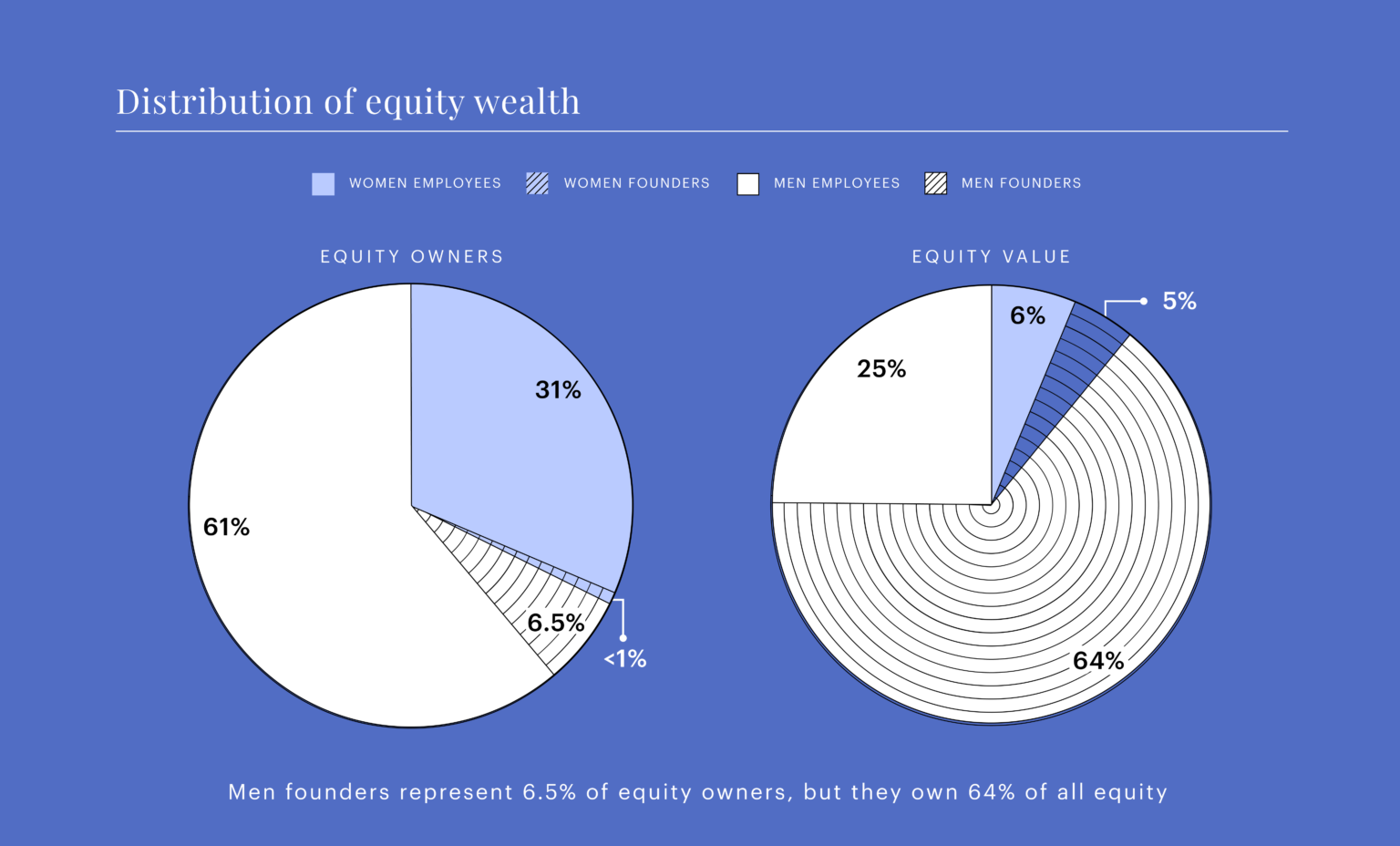
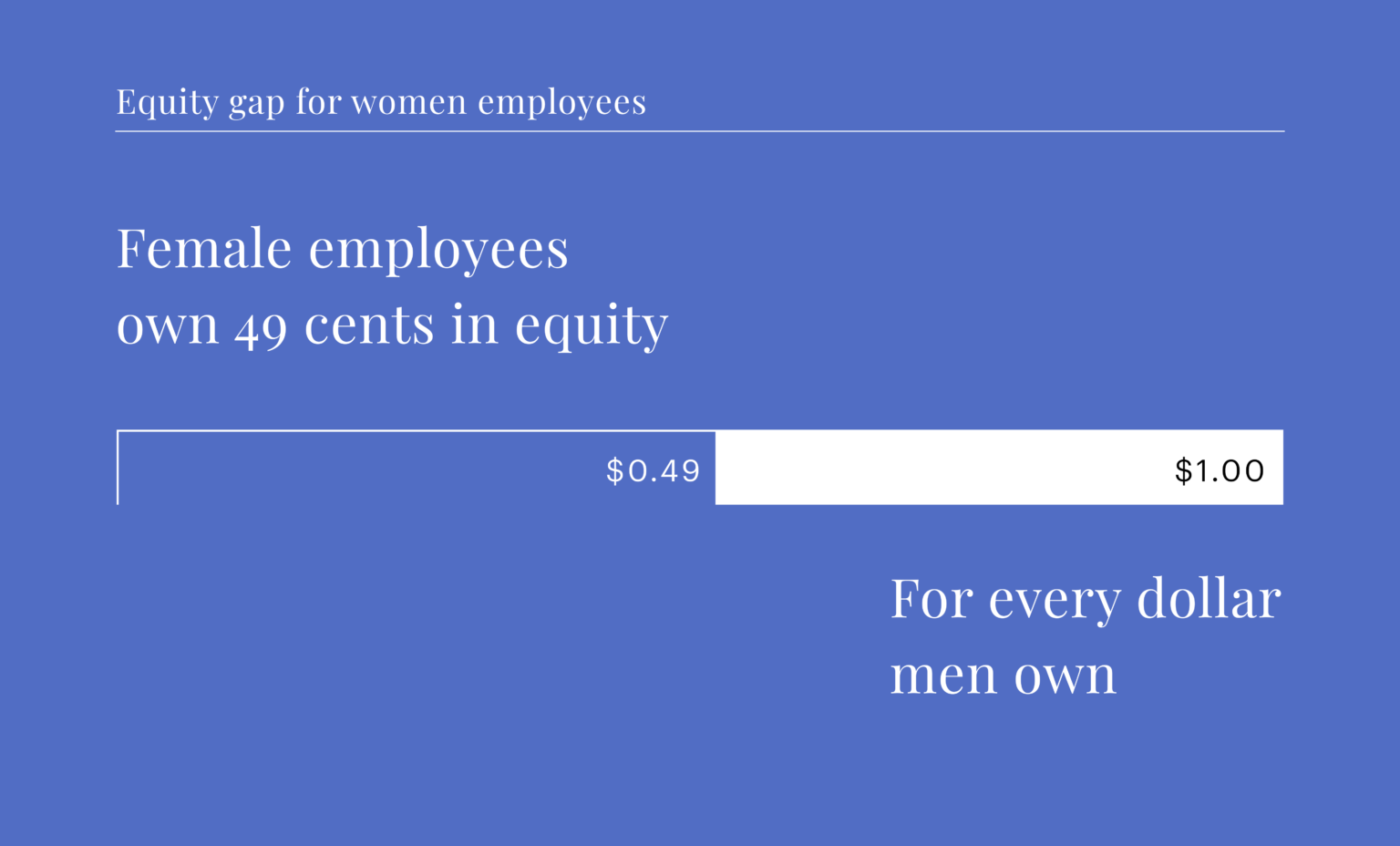
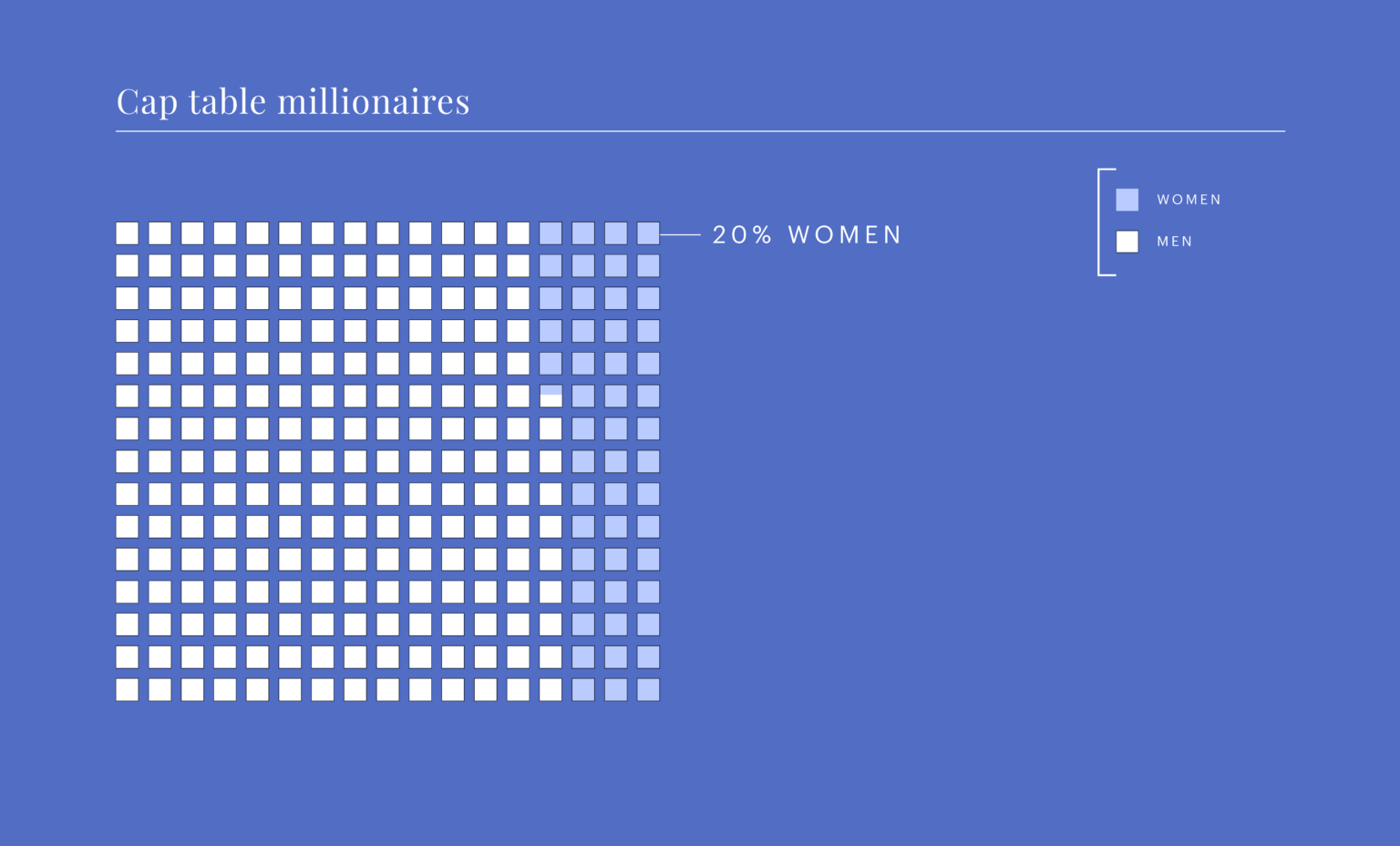
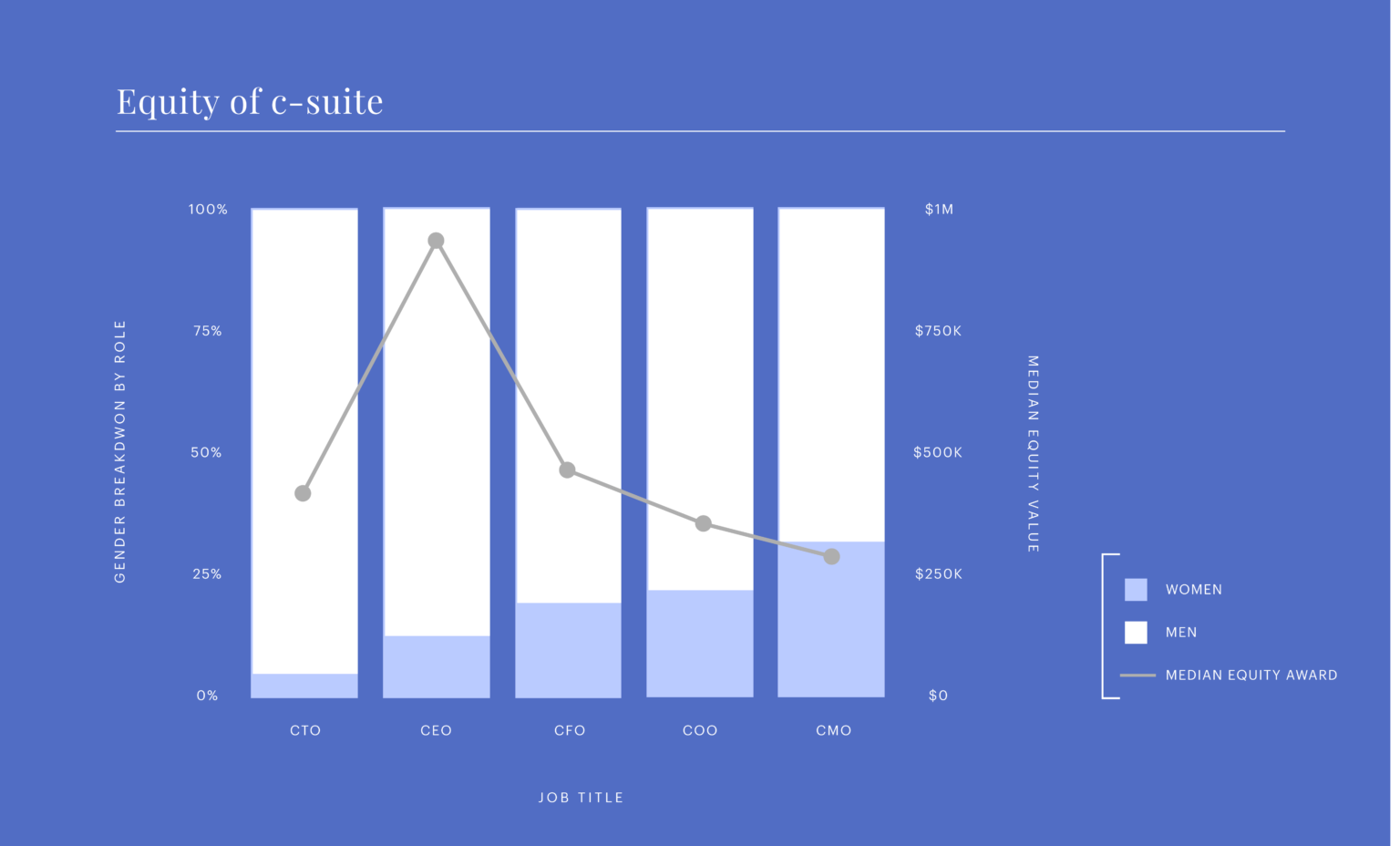
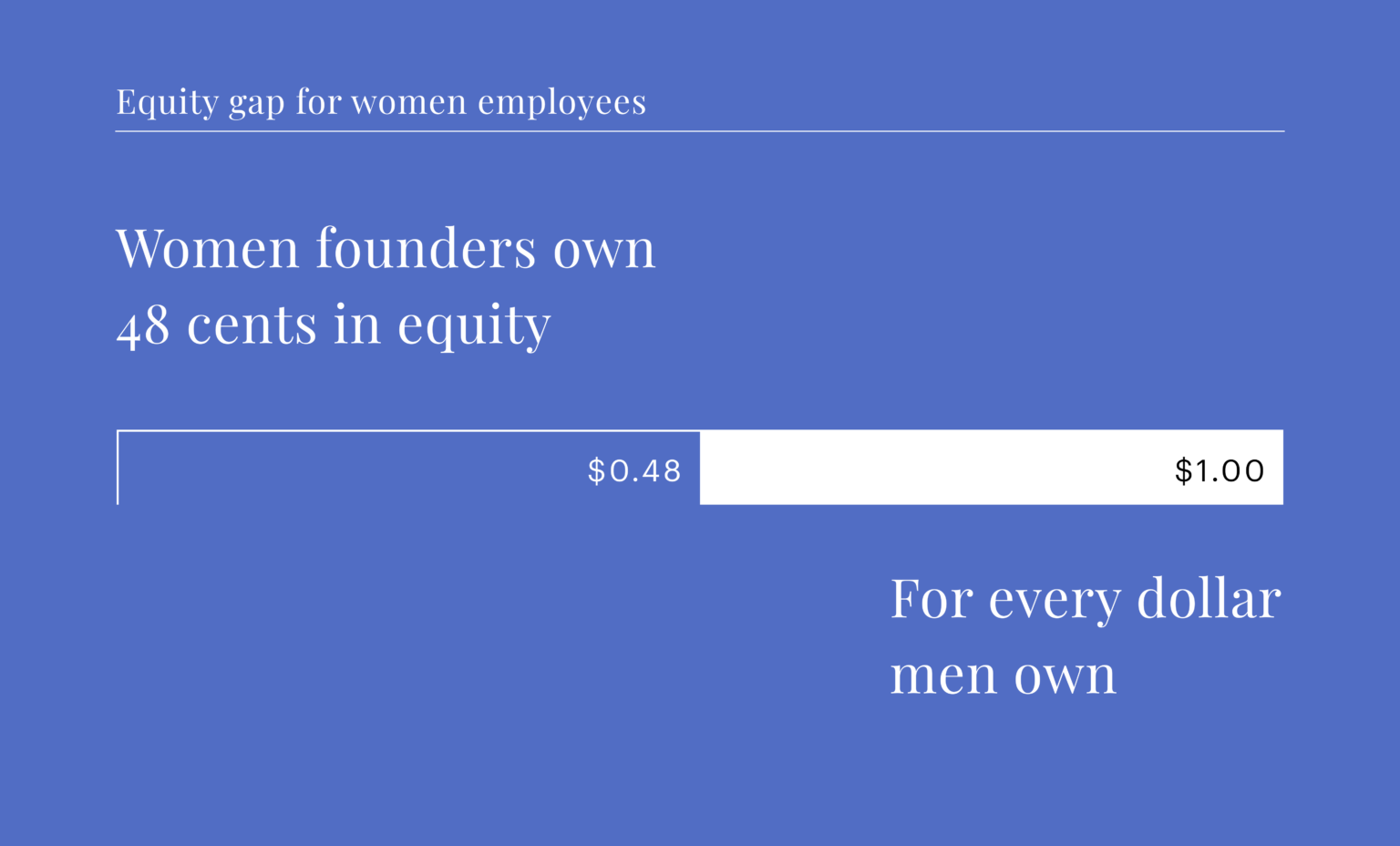
Data summary
Employee equity gap
Distribution of wealth: In aggregate, founders hold more than double (2.2X) the total amount of equity that employees own.
Team breakdown: Engineering teams have the highest average equity grant, and women represent less than 20% of engineering teams.
C-level breakdown: Only 1 in 8 CEOs is a woman, and CEOs get more than double the equity of the next highest compensated executive.
Cap table millionaires: Only 20% of cap table millionaires are women, and of hundred millionaires just 12% are women.
Cents on the dollar: Women employees own just 49 cents in equity for every dollar men own.
Founder equity gap
Distribution of wealth: Women founders hold 5% of total founder and employee equity in our study; men founders hold 64%.5
Cents on the dollar: Women founders own just 48 cents in equity for every dollar men founders own.6
Overall equity gap
Distribution of wealth: 96% of equity value is held by the top 20% wealthiest (founder and employee) equity holders. Of the wealthiest owners, only 9% are women.
Cents on the dollar: Women own just 11% of founder and employee equity, and hold 26 cents in equity for every dollar men own.7

Distribution of ownership
When you compare equity data to overall income data, the disparity is more pronounced. In the United States, 20% of income earners hold 77% of the wealth. Based on Carta’s data, we found:
-
20% of equity holders (founders and employees) own 96% of total equity value.
-
Of the 20% wealthiest equity holders, less than 1 in 10 are women.
-
7.5% of all individual equity holders are founders, and they hold 69% of the equity value.
Looking deeper into the distribution of equity, we found that men founders hold a much larger amount of equity in comparison to other groups.
-
Founders hold over two times the equity value of all employees combined.
-
Less than 1% of individual equity holders in our study are women founders; they hold 5% of the equity value.
-
Men founders make up 7% of equity holders; they hold 64% of the equity value.
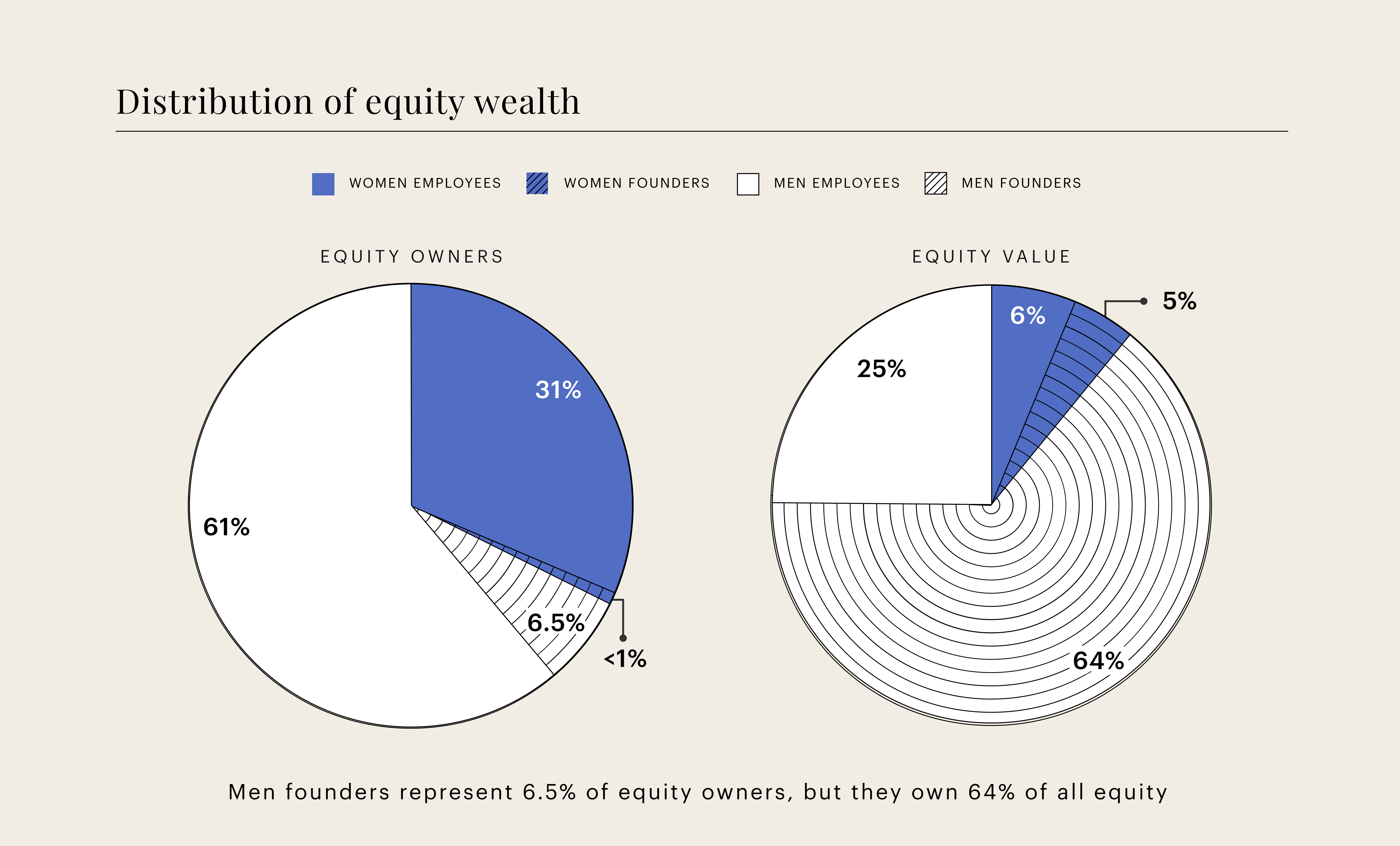
Cents on the dollar
Compensation gaps are typically quantified using cents on the dollar, so we use the same ratio to describe the gender equity gap. For example, women are paid between 78 to 82 cents on the dollar compared to men depending on the source. Our data answers the question, for every dollar a man holds in equity value, how much does a woman own?8
Employee cents on the dollar
One in three employees on Carta cap tables is a woman. And while 34% of employees are women, they only hold 20% of the equity wealth. This is what we mean by the equity gap. It’s not just that there are fewer women—it’s that they’re in roles that get less equity on average.
It’s not just that there are fewer women—it’sthat they’re in roles that get lessequity on average.
-
Women employees own just 49 cents in equity for every dollar men own.
-
Women employees make up 34% of employees in our study, but hold only 20% of employee equity wealth.
-
Women employees make up 31% of everyone in our study (founders and employees), but hold 6% of overall wealth.
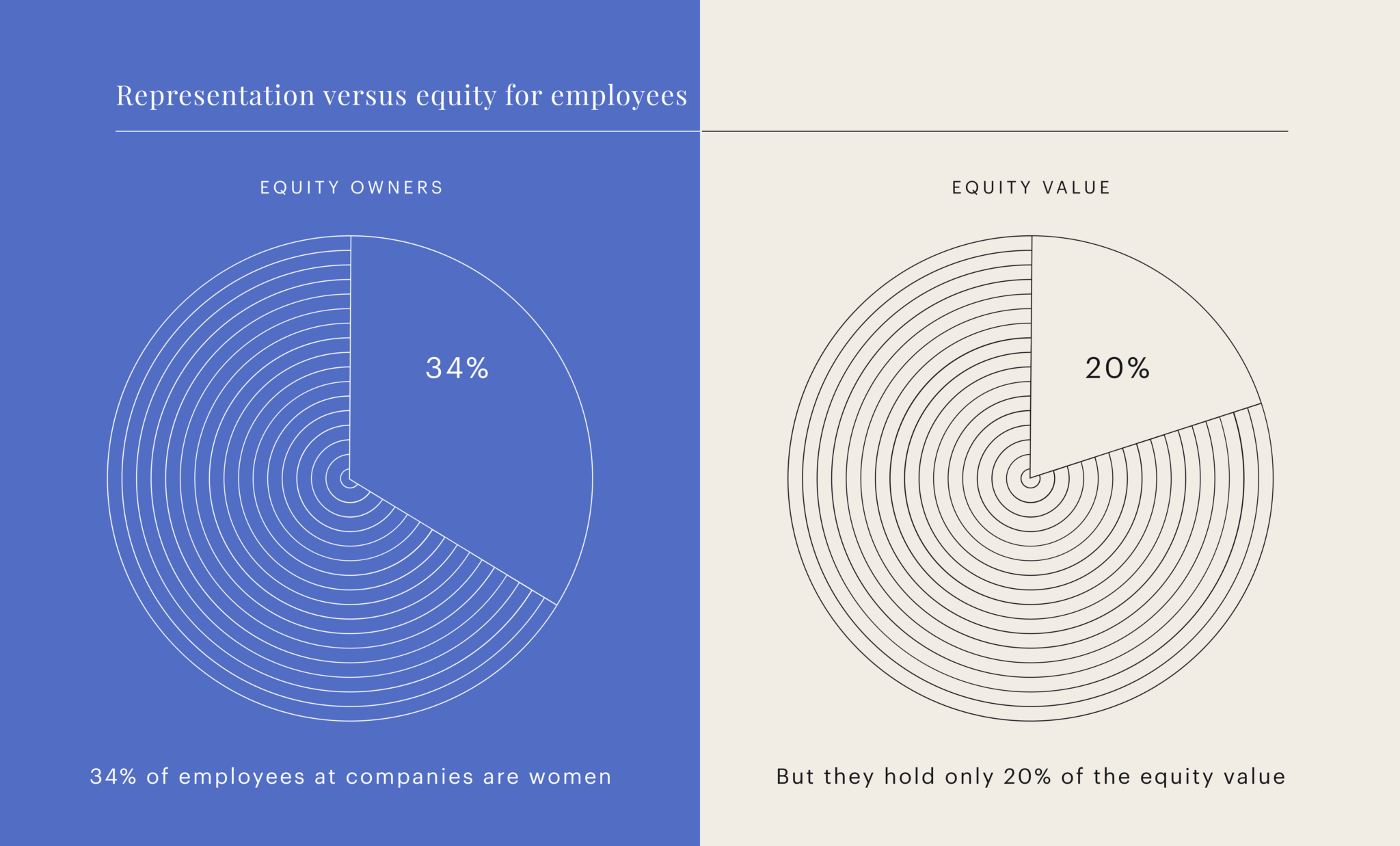
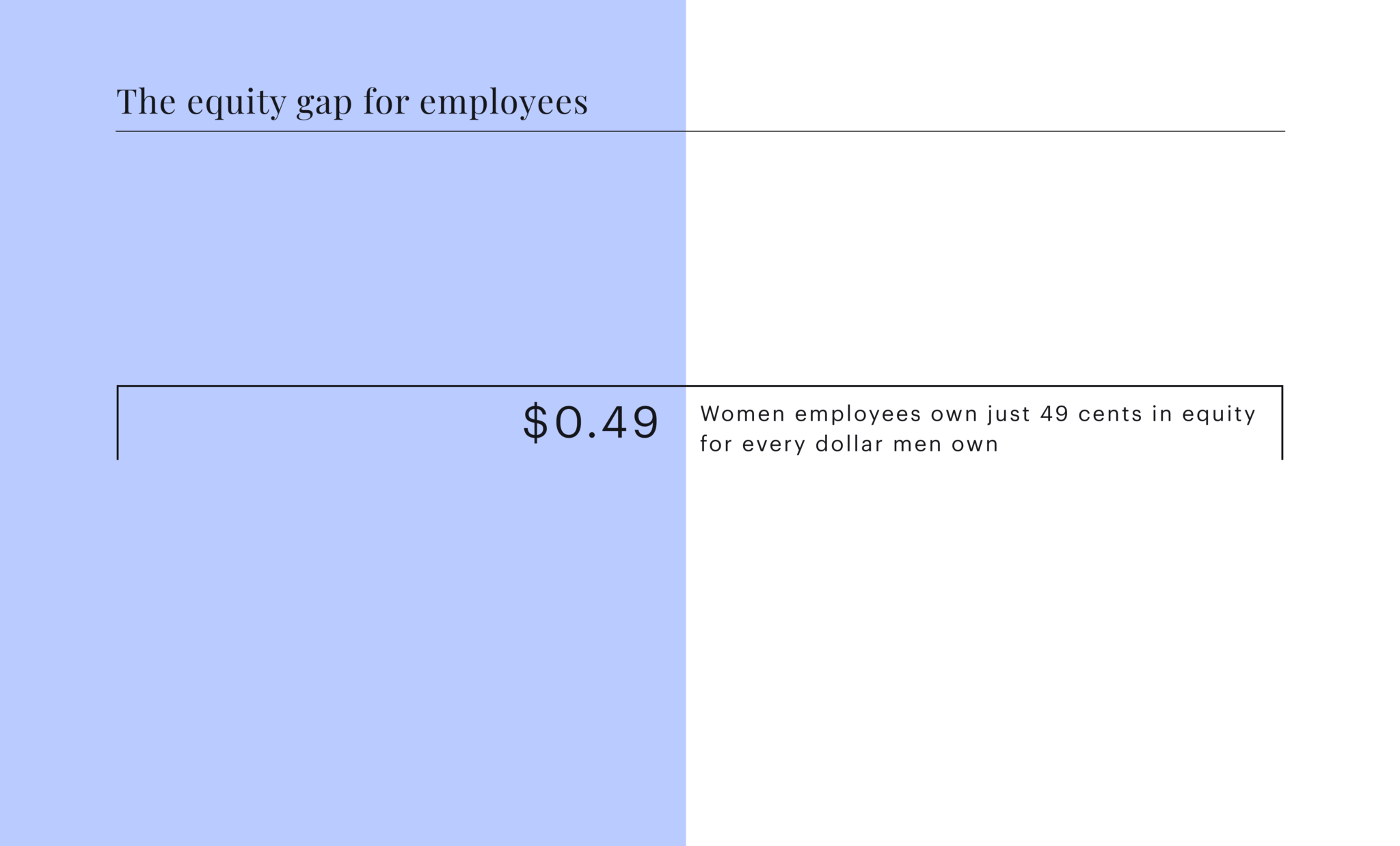
Founder cents on the dollar
Though we know women’s representation on founding teams is increasing, still very few individuals on cap tables are women founders. When you combine founders and employees, women founders represent less than 1% of all individuals on Carta cap tables. And women founders hold less than 5% of the overall equity. While men founders make up 5% of all founders and employees, they hold over 64% of the total equity value (see distribution of ownership graph above).
When you break this down for just founders, women founders represent 13% of all founders, and they hold 7% of founder equity value. This means that women founders own just 48 cents on the dollar in equity for every dollar men founders own.
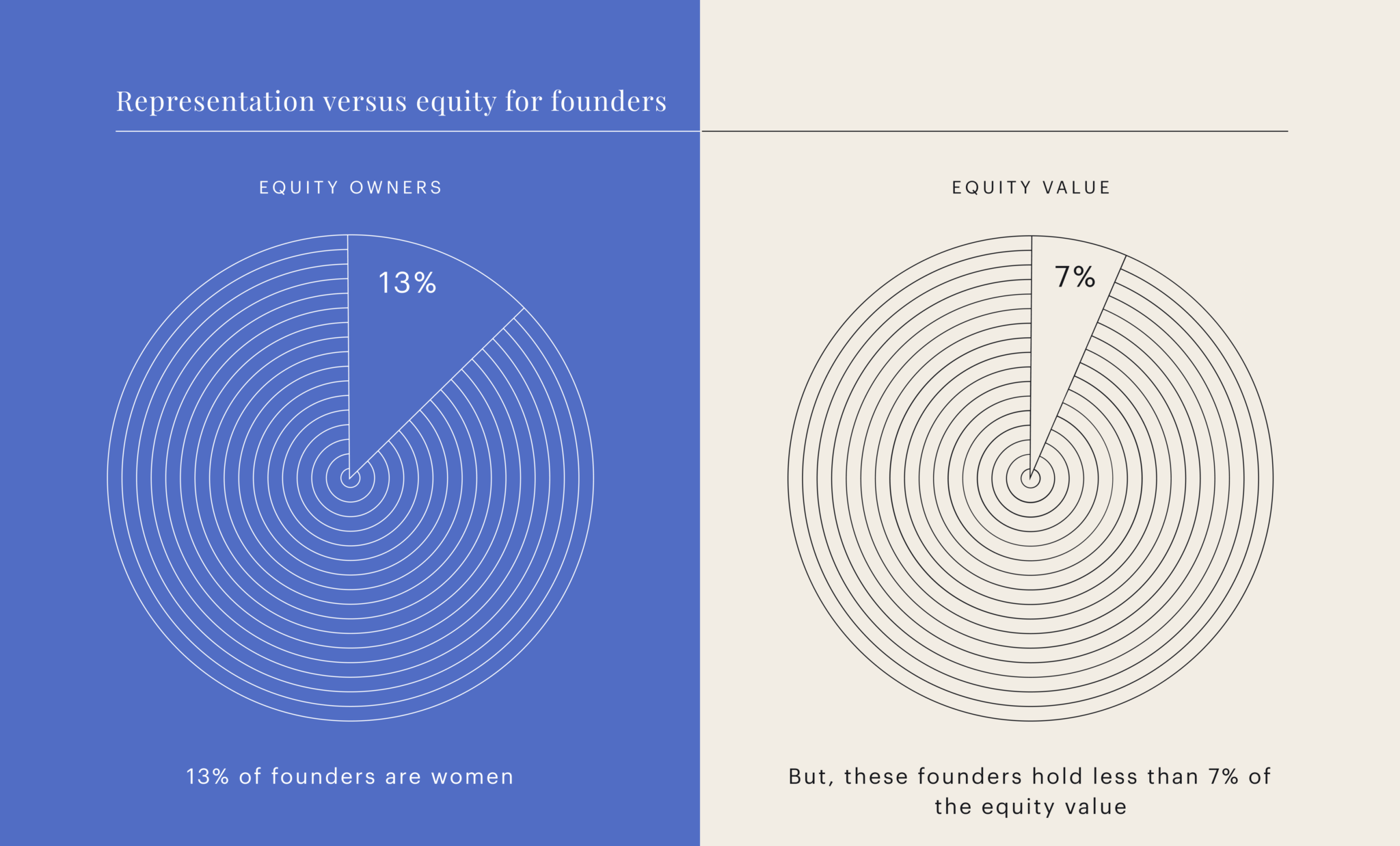
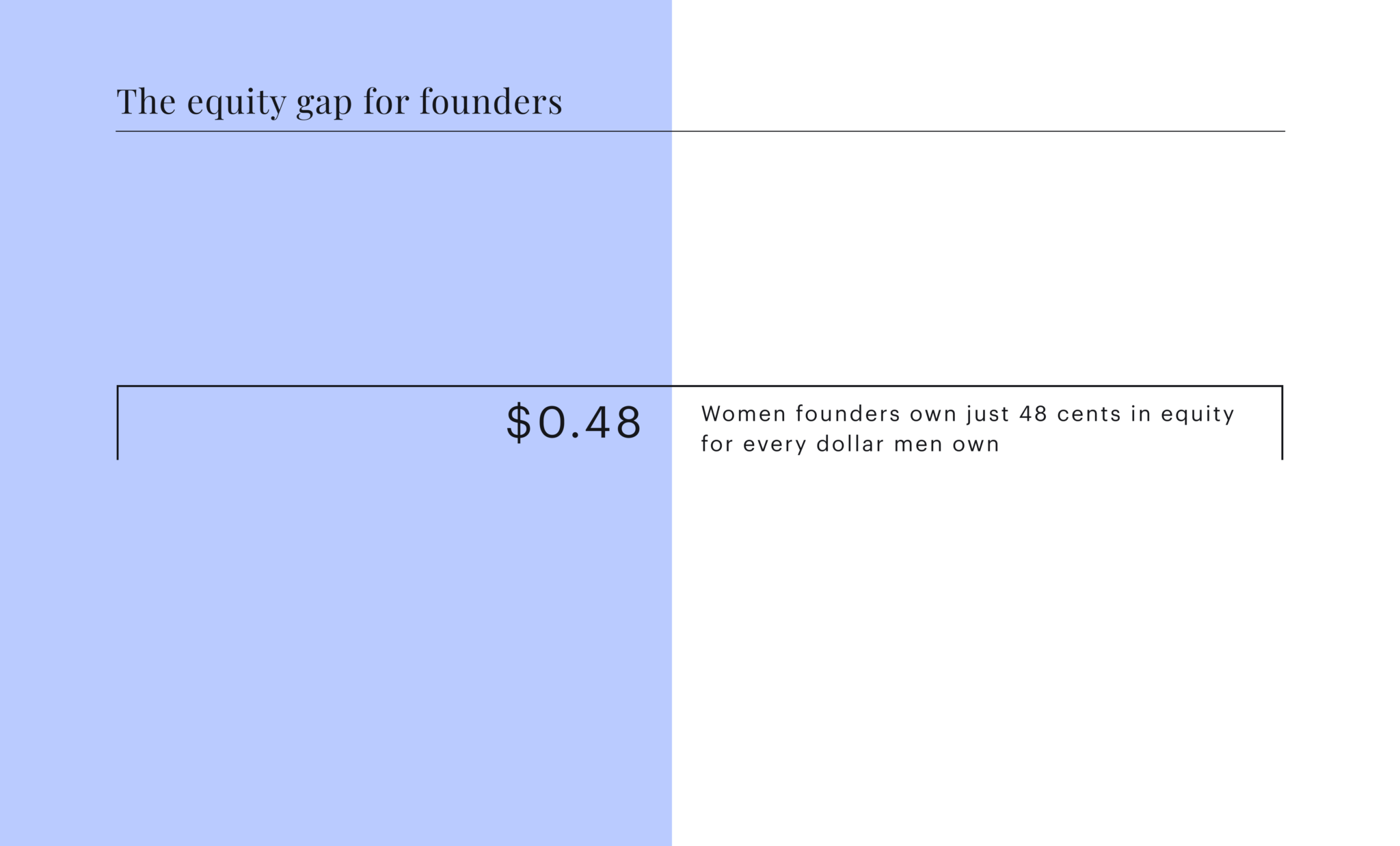
Overall cents on the dollar
When we combine founder and employee data, the overall equity gap measured by cents on the dollar is lower than both the founder equity gap and employee equity gap. While this math might seem counterintuitive, it is due to the extreme concentration of wealth among founders.9
-
Combined, women founders and employees own just 26 cents in equity for every dollar men own.
-
Women make up 32% of individuals in our study, but hold only 11% of the total equity wealth.
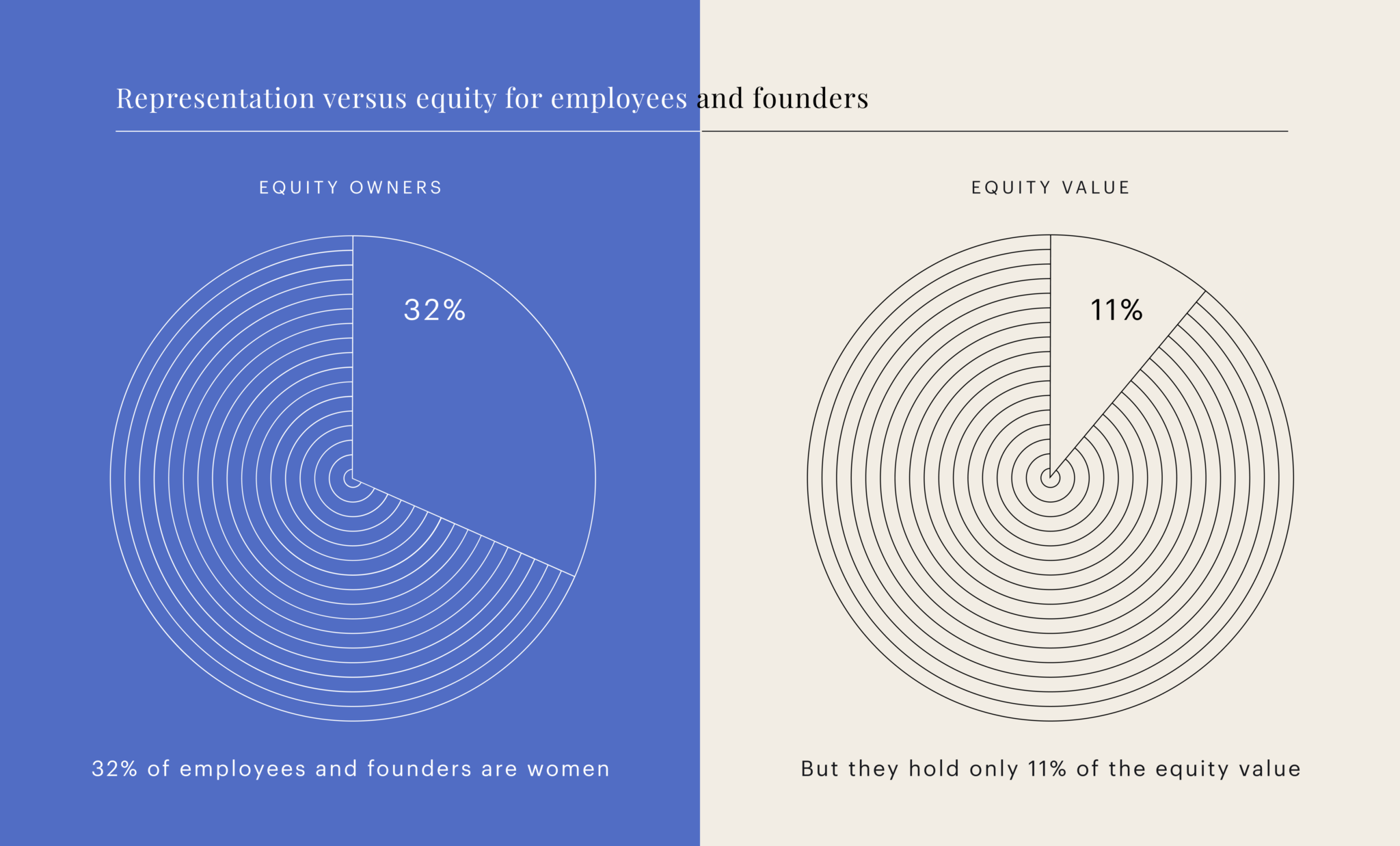
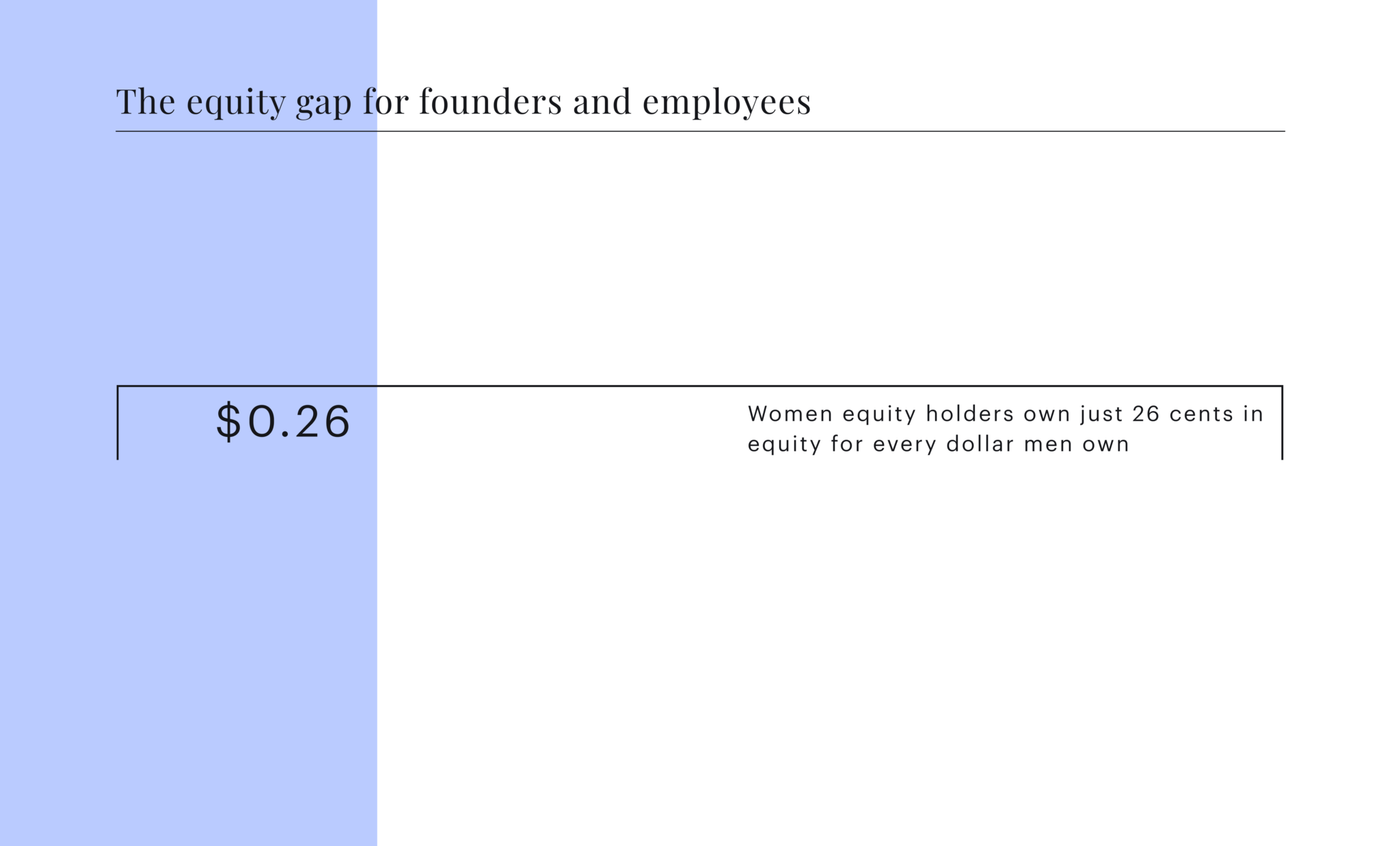
Cap table millionaires
Private markets are illiquid compared to public markets, and wealth remains locked up on the cap table and out of the pockets of its owners for years—even decades. We believe that in the near future, successful companies will regularly offer liquidity events (like tender offers). When liquidity happens, who will get rewarded? To answer this, we looked into what we’ve termed “cap table millionaires.”10
Our cap table millionaire data provides a different lens on the equity gap. If all venture-backed companies with cap tables on Carta provided employee liquidity, how many people would earn more than a million dollars from their equity stakes? What percentage of these potential millionaires are women? And if we extrapolate from this data, what does this look like for the entire venture-backed ecosystem?
We found that only 20% of cap table millionaires are women.11 To estimate the number of founder and employee cap table millionaires, we applied market share and exit multiples to our data.12 Based on this, we estimate that in the US there are nearly 130K cap table millionaires, 15K ten millionaires, and just over 1K hundred millionaires.13
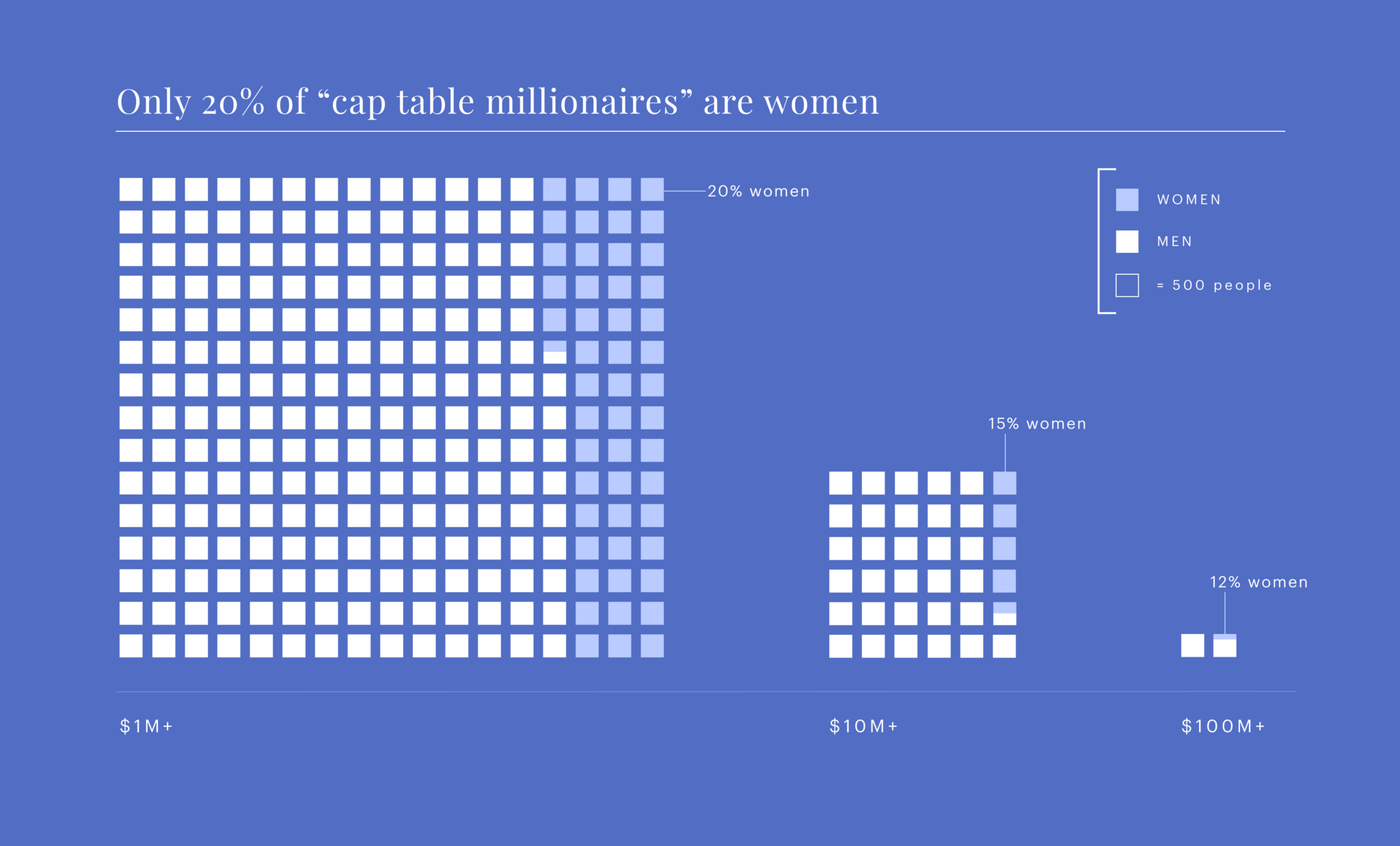
Team and role breakdown
To more deeply understand why the equity gap exists, we used our data to determine if women in the same roles as men are compensated with less equity (all else being equal—start date, option type, strike price, etc).
Our current dataset indicates that employees in the same role are compensated with equal equity. The study shows that the gap exists because women aren’t in the right roles at the right time—the roles with outsized equity.
Women don’t start early enough
In companies under 20, women represent less than 30% of employees. For successful companies, strike prices typically rise as companies grow and raise more money. All else equal, early employees have the potential for more earnings.14
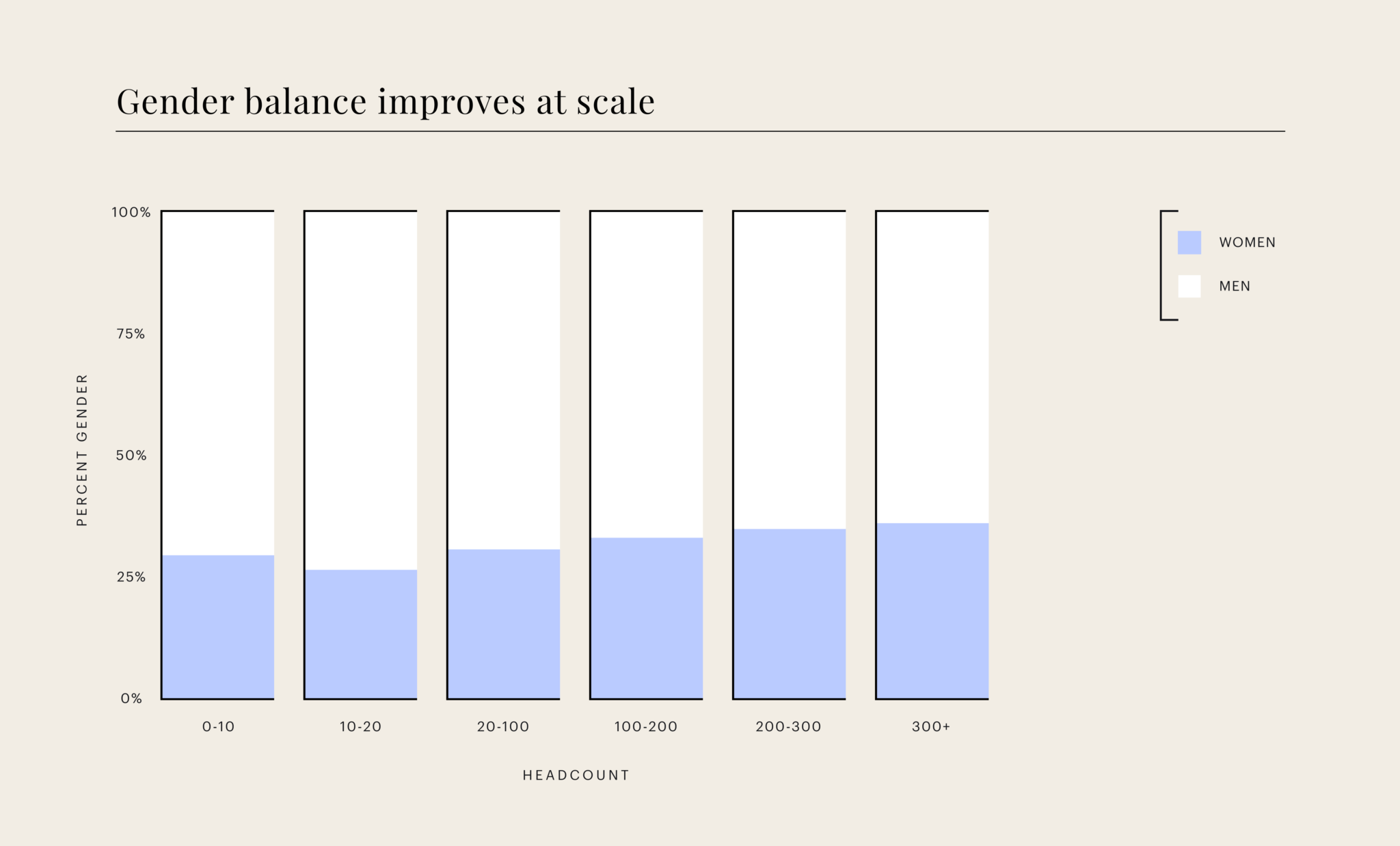
Women aren’t well-represented in high-equity roles
For individual roles, we did not find a significant gender equity gap.15 Founders are an exception; women founders own 48 cents for every dollar men own. More senior roles typically get more equity, and specific departments get more equity than others. Across most departments, women are represented less and less as they move up the ladder into Director, VP, and C-suite roles. Plus, the two C-level roles in our study with the highest percentages of women (CMO and COO) get less equity than other C-level roles.16
-
Only 1 in 8 CEOs is a woman. CEOs get more than double the equity of the next highest compensated executive (CFOs).
-
Chief Marketing Officers, the executive role in which women are most represented (32%) have the lowest median equity award, 39% less than that of CFOs.
-
Finance has the highest increase in equity from lower-level to C-suite roles—a 26X increase. But, as seniority increases on finance teams, women representation decreases by 70%.
-
Engineering has the lowest representation of women compared to the other teams in our study. Women engineers are less than 20% of engineers in our study, at every level.
-
Comparing junior and mid-level employees, engineers receive equity grants that are more than double that of any other department, on average.
17

For most teams, % of women dramatically declines with seniority
Engineering
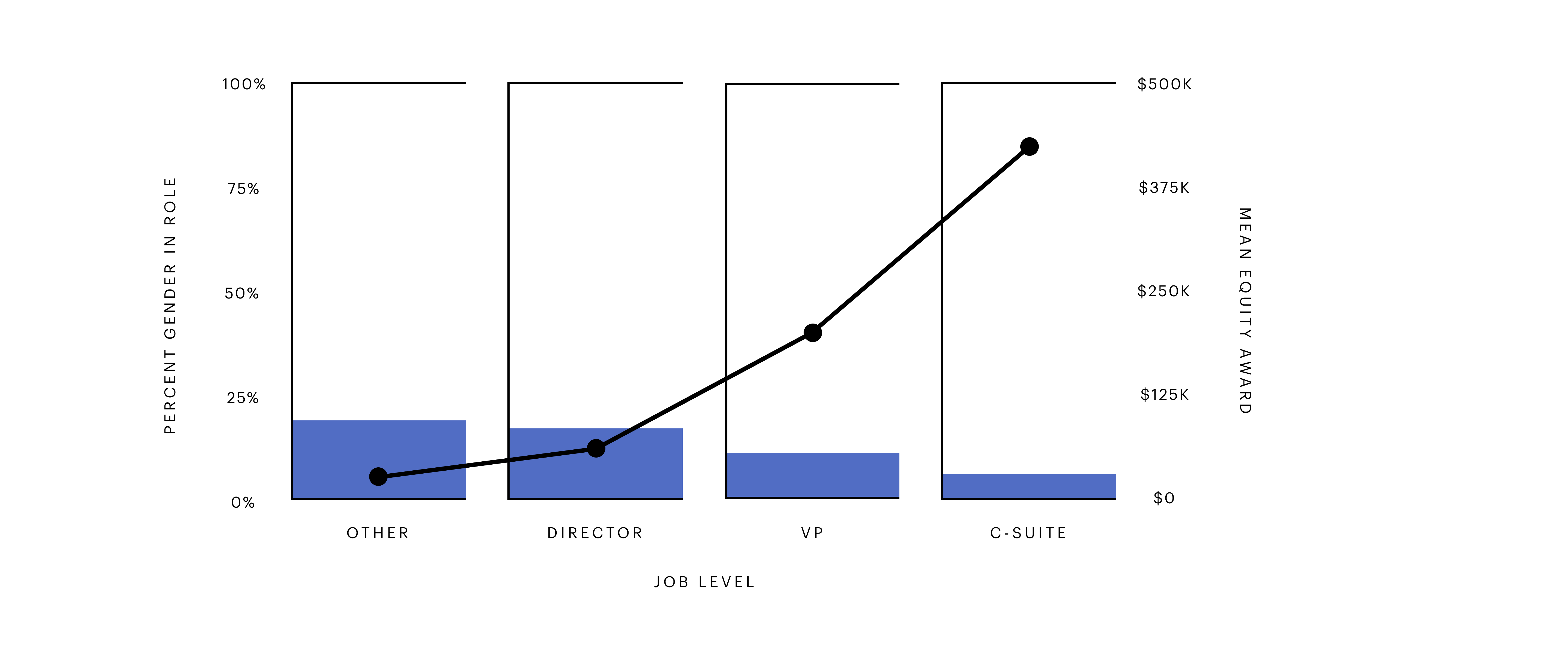
Finance
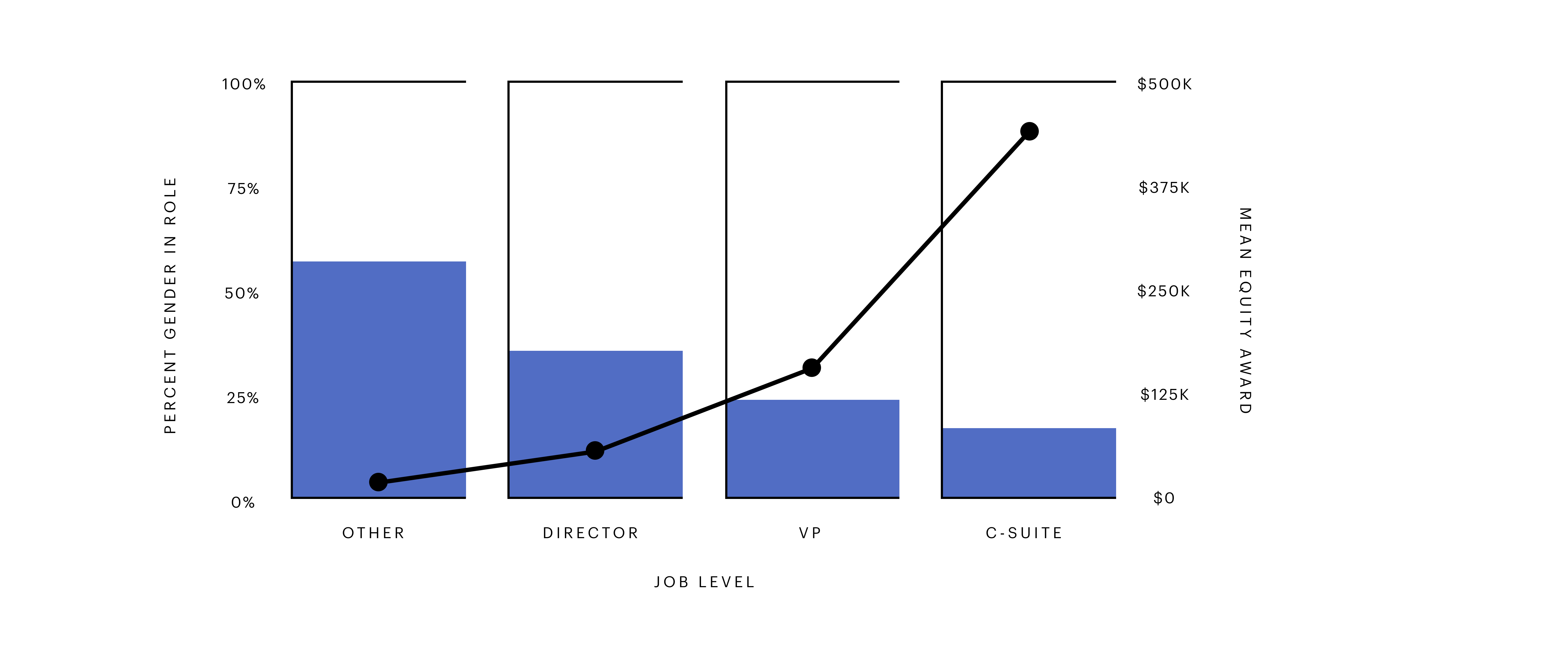
Marketing

Sales + Operations
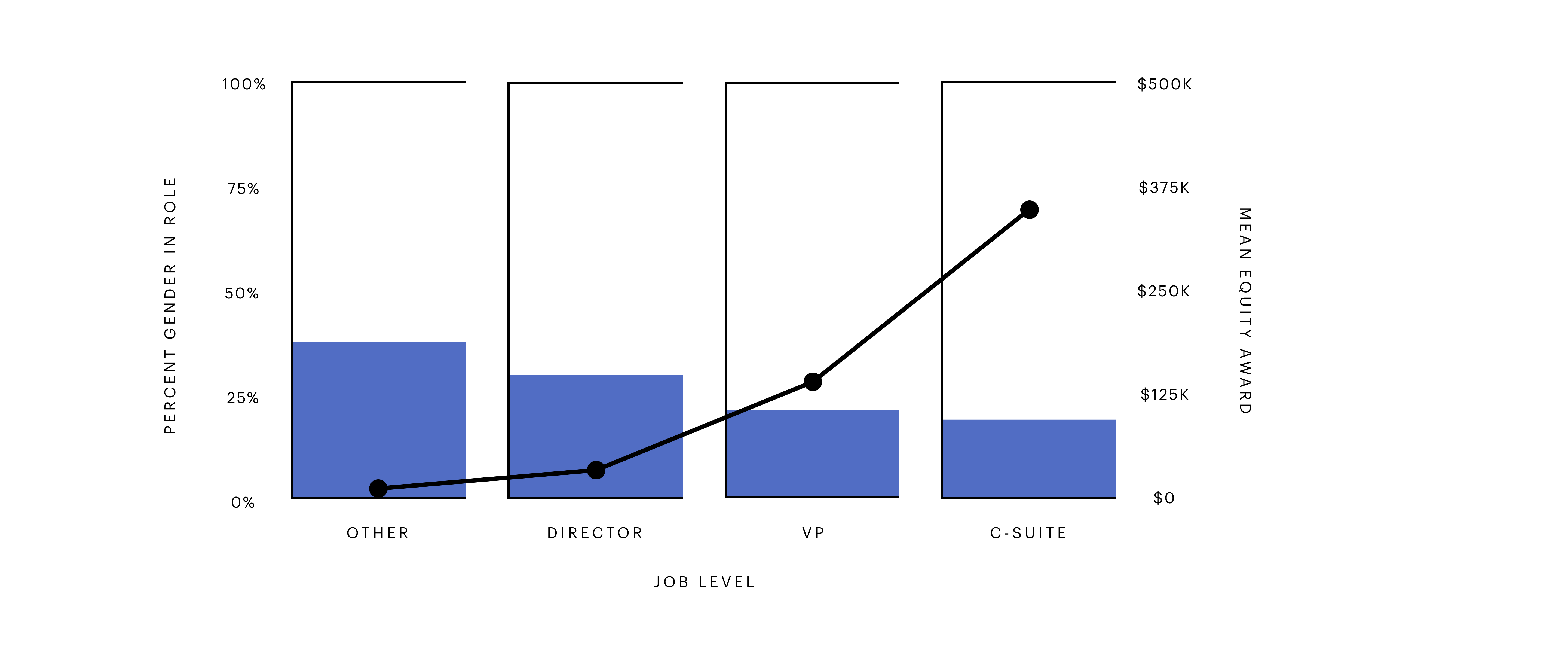
Fair equity is table stakes
The individuals on cap tables today are the founders, venture capitalists, and limited partners of tomorrow. Due to the amount of wealth created by private company ownership—and the inclination to hire people like yourself, from your own network—the impact of the gender equity gap ripples through our economy and will continue to perpetuate itself. We must close the gap now.
Today’s employees are the founders, VCs,and limited partners of tomorrow.
At Carta, we believe fair equity and liquidity practices are table stakes. We appreciate our community’s support and plan to continue to develop not only products and services, but also research, education, and programs to help close the equity gap and create more owners. The more we share and talk about a problem, the more brain power we have to find solutions. Equal equity is table stakes.
November 4, 2019By Emily KramerSpecial thanks to Erin Boehmer, Ray Raff, & Grace Erickson
Here’s how we believe you can help, no matter who you are:
Employees
-
Learn about equity and negotiate. Rarely will a company decline your offer altogether because you negotiate—so what do you have to lose?
-
Don’t be afraid to ask for what you believe you’re worth, whether that be salary, equity, or a promotion. Here’s what to ask when you get an offer.
Managers
-
Hire women and underrepresented minorities (URMs). The cards are stacked against them, and it’s time we turn the tables.
-
Make sure you aren’t under-leveling URMs on your team. Specifically, make sure that within roles, the skill sets and achievements of employees match each other.
-
Do not ask candidates to tell you their current salary and equity award—offer them what they are worth to your company. In some states, this is even illegal.
-
Join companies with transparent and fair equity practices that care about and diversity and inclusion. Carta’s Employee Shareholder Bill of Rights is a guide for fair equity practices.
Founders
-
Seek co-founders and early employees outside of your community. Diverse perspectives help.
-
Make sure you understand the equity split within your founding team and that you feel comfortable with it. If you have concerns, speak to a lawyer together.
-
Every founder, not just URMs, should ask VCs about their track record investing in companies with diverse teams.
-
Find venture funds focused on URM founders. Then, obviously, get them great returns, so limited partners put more money into these funds in the future. Prove the naysayers wrong.
Investors
-
Give clean terms to founders.
-
Find deal flow outside of your inner circle.
-
Join or start firms that care about diversity and inclusion.
-
Require your portfolio companies to have at least one URM on their board—preferably more. This is already a requirement in California for public companies.
-
Require your companies to diversify their leadership teams and promote from within.
Glossary
409A valuation: An independent appraisal that determines the FMV of a private company’s common stock. It’s usually used to figure out how much employees should pay to exercise (purchase) their stock options. Learn more.
Cap table: A list of all the securities a company has issued and who owns them. Learn more.
Common stock: Stock commonly reserved for employees. Learn more.
Equity: The value of stock issued by a company.
Exit: When a private company does something that radically changes the ownership structure of the company, such as going public or getting acquired.
FMV (Fair market value): What one share of a private company’s common stock would be worth on the open market. Learn more.
Liquidity: When an asset (such as shares of stock) can be converted into cash. Learn more.
Options: The right to buy shares of company stock at a specific price. Learn more.
Preferred stock: Stock commonly reserved for investors. Learn more.
RSU (restricted stock unit): A promise from a company to give shares of company stock (or the cash equivalent) on a future date if certain restrictions are met. Later-stage and public companies often offer employees RSUs instead of stock options. Learn more.
Securities: Financial assets that usually represent ownership in a company and hold monetary value. Securities include stock, convertible notes, warrants, and equity grants.
Shareholder/security holder: Anyone who owns shares of company stock/securities in a company.
Stock appreciation rights: A bonus companies can give employees. Unlike stock options, employees don’t have to pay anything to receive this benefit—they simply receive the sum of the appreciation of company stock over a set period of time.
Strike price: The set price at which someone can purchase their stock options. It’s usually the FMV of the company’s common stock when the option grant was issued. Learn more.
Tender offer: A company-sponsored liquidity event that typically allows multiple sellers to sell their shares either to an investor or back to the company. Learn more.
Methodology
Carta helps over 13,000 companies and 800,000 security holders (described as equity holders in the study) manage equity. These security holders include founders, board members, consultants, employees, and investors almost entirely in the United States. This study uses a sample of Carta’s founder and employee cap table data, aggregated and anonymized. Companies who have contractually requested that we not use their data in anonymized and aggregated studies are not included in this analysis. We limited our study to the following security types: options, restricted stock units (RSUs), stock appreciation rights (SARs), and common stock (granted to founders). These are the most commonly held securities by founders and employees.
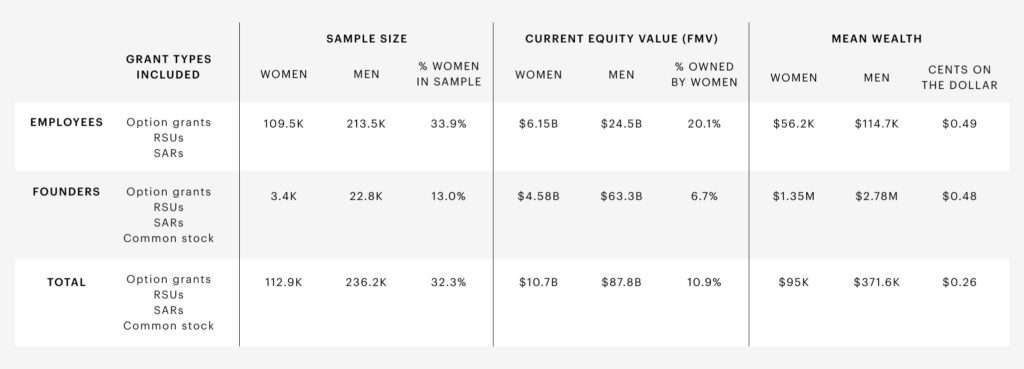
Matching gender
Because Carta does not currently collect gender information, we categorized names by gender using aggregate name data from both the U.S. Social Security Administration and Gender API. Using a taxonomy does have its shortcomings, but this was the most accurate and widely-used approach given our dataset:
-
Using this approach, approximately 6% of individuals were removed because we could not match their names. We considered first names with less than 85% gender accuracy too ambiguous to classify. This may mean that names not popular in America were excluded more often.
-
While we recognize that gender is non-binary, we were only able to associate names to women and men. We describe the equity gap using gender (woman/man) terms rather than sex (female/male) because we acknowledge sex does not always accurately reflect an individual’s identity.
-
We were also unable to map our cap table data to ethnicity, as Carta does not currently collect this data. You can self-report your demographic data to build out our dataset here, and we plan to voluntarily collect more information in Carta in the future.
-
To keep data anonymized, we classified gender using first names only independently of equity data.
Valuing equity
To calculate the value of these options, we used two methods:
-
For most calculations we use fair market value (FMV). We took the current FMV of common stock based on the company’s last 409A valuation, subtracted the strike price per option, and multiplied by the quantity of securities held by the individual. We recognize that prices offered during a liquidity event are typically not the same as FMV, therefore we use percentages as frequently as possible instead of just equity value.
-
We used 409A valuation, rather than investor valuation, since 409A valuations are required to be updated in Carta regularly (every year, or every time a company has a material event).
-
For equity value by role we used Black-Scholes data to better represent the value of the grant at the time of issuance rather than its current value.
Distribution of ownership
To analyze the distribution of equity ownership, we ranked all founder and employee equity owners in order of their overall equity holdings (based on FMV). We then look at the ratio of women in each percentile.
Cents on the dollar
-
Cents on the dollar = mean wealth of women divided by mean wealth of men.
-
Mean wealth = total current equity value, based on 409A valuation, divided by the total number of security holders.
Cap table millionaires
To estimate the number of cap table millionaires, ten millionaires, and hundred millionaires, we applied two multiples to our founder and employee data:
-
We divided our data set by Carta’s market share percentage by segment to predict the number of individual cap table millionaires (founders and employees) at US venture-backed companies.
-
To account for the fact that exits and fundraising typically occur at a three times multiple of a 409A valuation, we applied a multiple to equity holdings. The multiple was determined by looking at the average ratio of common stock to preferred stock, based on the investor valuations at the last fundraising round.
Without applying these multiples, and looking at FMV and individuals on Carta cap tables only, we got the below results:
-
Cap table millionaires (individuals with > $1M in FMV equity value): 6,584
-
Cap table ten millionaires (> $10M in FMV equity value): 1,399
-
Cap table hundred millionaires (> $100M in FMV equity value): 563
Headcount
-
Headcount includes founders and employees.
-
Sample size of each grouping ranges from 29K to 131K security holders
Role breakdown
-
All role information in Carta is self-reported. We did not include roles that we could not easily categorize in a department (such as “team lead” or “analyst”).
-
Sample sizes for roles ranges from 130 to 20,000; we ruled out any roles with sample sizes of less than 100.
Footnotes
1 The mean gender salary gap in the United States ranges from 78 cents to 82 cents on the dollar depending on source. 2 While we recognize that gender is non-binary, we were only able to associate names to women and men. 3 Companies who have contractually requested that we not use their data in anonymized and aggregated studies are not included in this analysis. 4 VC firms are represented on cap tables as a single entity, not as individual investors. We cannot attribute equity to individuals at VC firms because carried interest varies and is often not disclosed. All Raise and Pitchbook have conducted studies looking specifically at women investors. 5 In this study, we considered “founders” to be any individual granted more than 1% in common stock. 6 Our total employee sample size increased from 181K to 323K from 2018 to 2019. The percentage of women founders in our sample of founders stayed consistent at 13%. 7 When we combine founder and employee data, the overall equity gap measured by cents on the dollar is lower than both the founder equity gap and employee equity gap. While this math might seem counterintuitive, it’s best explained by Simpson’s Paradox. In the Methodology section, you can review our data and formulas. 8 From 2018 to 2019, the employee equity gap went from 47 to 49 cents and our employee sample size increased from 181K to 323K. The founder equity gap went from 39 to 48 cents and our founder sample size increased from 15K to 26K. 9 This is best explained by Simpson’s Paradox. In the Methodology section, you can review our data and formulas. 10 “Cap table millionaires” includes all issued options and common stock of founders and employees. If an individual gets multiple grants, they are counted as 1 person. 11 Without multiples, there are about 6,500 cap table millionaires on Carta cap tables. 12 We divided our data set by Carta’s market share percentage by segment to predict the number of individual cap table millionaires at US, venture-backed, private companies. To account for the fact that exits and fundraising typically occur at a valuation that is 3X a 409A valuation, we multiplied the fair market value (FMV) of each individual’s equity holdings by three. 13 Multiple was determined by looking at the average ratio of common stock to preferred stock, based on valuations at the last fundraising round. 14 The difference between their strike price and exit price (earnings per share) is typically larger later as a successful company grows. 15 As our sample size for each role increases in the future, we hope to be able to analyze this more closely. 16 Due to sample size and varying names of teams and roles, we were only able to analyze some teams and roles. 17 Junior and mid-level includes everyone except Directors, VPs, and C-Levels in our study.
